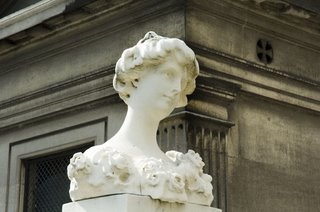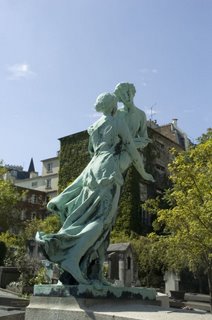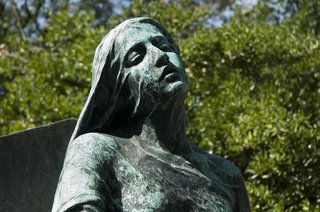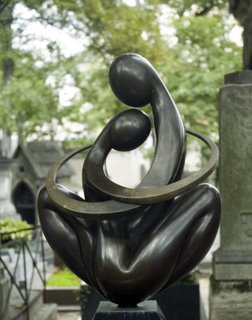
A little less than 5 acres in size, Passy cemetery (opened in 1820), like St. Vincent in the 18th arr., is small, intimate and yet with much of the same characteristics found in the larger cemeteries in Paris: the look and feel of a necropolis, long avenues marked by benches, shading trees, and fantastic sculpture full of pathos, humor and life even in death. But unlike the Big Three cemeteries, Passy feels like a small village rather than a city, making you feel as if you were in a city whose inhabitants have all just stepped out to lunch. (photo: "Lolita" in division 2.)
Located just behind the Palais de Chaillot in the Trocadero area the cemetery is easily reached by Metro (Trocadero stop). (In fact the architect of the rather unattractive decaying hulk of the Palais, Jacque Carlu is buried in Passy.)
 Culbertson/Randall is unfortunately of little help here. Apparently when the authors visited Passy preparing the 1986 edition of their guide they found that the cemetery was "not officially divided into sections” and as a result produced their own division numbering layout “to facilitate touring.” Today, however the cemetery is divided up into divisions which are clearly located on the official cemetery map – along with the ubiquitous large map near the entrance as well. And believe me a map here is essential as there are neither division markers nor any street signs in the cemetery proper. I also used Bertrand Beyern’s “Guide des tombes d’hommes celebres” which is a big help – he provides both a clear listing division-by-division of the well known buried here as well as a nice map of his own. (photo: I read somewhere that the tower was originally painted bright yellow.)
Culbertson/Randall is unfortunately of little help here. Apparently when the authors visited Passy preparing the 1986 edition of their guide they found that the cemetery was "not officially divided into sections” and as a result produced their own division numbering layout “to facilitate touring.” Today, however the cemetery is divided up into divisions which are clearly located on the official cemetery map – along with the ubiquitous large map near the entrance as well. And believe me a map here is essential as there are neither division markers nor any street signs in the cemetery proper. I also used Bertrand Beyern’s “Guide des tombes d’hommes celebres” which is a big help – he provides both a clear listing division-by-division of the well known buried here as well as a nice map of his own. (photo: I read somewhere that the tower was originally painted bright yellow.)
After Pere Lachaise Passy is most certainly my favorite cemetery and given its location and manageable size – not much larger than some outdoor galleries – I urge you to try and spend an hour or so wandering around here. You won’t regret it.
 For a space this small, in the very shadow of the Eiffel tower, some truly remarkable people are buried here:
For a space this small, in the very shadow of the Eiffel tower, some truly remarkable people are buried here:
Composers Claude Debussy, Gabriel Faure, aviators Henry Farman, Maurice Bellonte and Dieudonne Costes, actresses Pearl White (of “Perils of Pauline” fame) and Jane Henriot (‘she came, she smiled, she left”), Bao Dai the last emperor of Vietnam, impressionist Edouard Manet, Marcel Renault (yes one of the Renault briothers who founded the company), Princess Leila Pahlevi, a daughter of the last shah of Iran. (photo: Jane Henriot in division 15.)
Also buried here are folks whose names are largely unknown but whose memorials are a testament to their wit and imagination: Harry Sharon, Albert Laurans, the Sander family, the de Sa Valle family, the Madrenas y Satorres family, Adelaide Boisseree and the enigmatic bit of stone over the family of Jose de Saz Cabellero:

One curious note here. Culbertson/Randall, as well as Beyern and Fred Sofi list a large, striking piece of sculpture over the tomb of Antoine Cierplikowsi; Sofi even notes that the piece was done by X. Dunikowski (although Xavera Dunikowski the Polish sculptor died in 1964, some 12 years before Cierplikowski). The photo of this sculpture in Culbertson/Randall is powerful indeed – unfortunately it doesn’t seem to be there any longer. In fact, the cemetery does not list it on its map nor have I been able to glean any information from them about what happened. Maybe you know?
Located just behind the Palais de Chaillot in the Trocadero area the cemetery is easily reached by Metro (Trocadero stop). (In fact the architect of the rather unattractive decaying hulk of the Palais, Jacque Carlu is buried in Passy.)
 Culbertson/Randall is unfortunately of little help here. Apparently when the authors visited Passy preparing the 1986 edition of their guide they found that the cemetery was "not officially divided into sections” and as a result produced their own division numbering layout “to facilitate touring.” Today, however the cemetery is divided up into divisions which are clearly located on the official cemetery map – along with the ubiquitous large map near the entrance as well. And believe me a map here is essential as there are neither division markers nor any street signs in the cemetery proper. I also used Bertrand Beyern’s “Guide des tombes d’hommes celebres” which is a big help – he provides both a clear listing division-by-division of the well known buried here as well as a nice map of his own. (photo: I read somewhere that the tower was originally painted bright yellow.)
Culbertson/Randall is unfortunately of little help here. Apparently when the authors visited Passy preparing the 1986 edition of their guide they found that the cemetery was "not officially divided into sections” and as a result produced their own division numbering layout “to facilitate touring.” Today, however the cemetery is divided up into divisions which are clearly located on the official cemetery map – along with the ubiquitous large map near the entrance as well. And believe me a map here is essential as there are neither division markers nor any street signs in the cemetery proper. I also used Bertrand Beyern’s “Guide des tombes d’hommes celebres” which is a big help – he provides both a clear listing division-by-division of the well known buried here as well as a nice map of his own. (photo: I read somewhere that the tower was originally painted bright yellow.)After Pere Lachaise Passy is most certainly my favorite cemetery and given its location and manageable size – not much larger than some outdoor galleries – I urge you to try and spend an hour or so wandering around here. You won’t regret it.
 For a space this small, in the very shadow of the Eiffel tower, some truly remarkable people are buried here:
For a space this small, in the very shadow of the Eiffel tower, some truly remarkable people are buried here:Composers Claude Debussy, Gabriel Faure, aviators Henry Farman, Maurice Bellonte and Dieudonne Costes, actresses Pearl White (of “Perils of Pauline” fame) and Jane Henriot (‘she came, she smiled, she left”), Bao Dai the last emperor of Vietnam, impressionist Edouard Manet, Marcel Renault (yes one of the Renault briothers who founded the company), Princess Leila Pahlevi, a daughter of the last shah of Iran. (photo: Jane Henriot in division 15.)
Also buried here are folks whose names are largely unknown but whose memorials are a testament to their wit and imagination: Harry Sharon, Albert Laurans, the Sander family, the de Sa Valle family, the Madrenas y Satorres family, Adelaide Boisseree and the enigmatic bit of stone over the family of Jose de Saz Cabellero:






